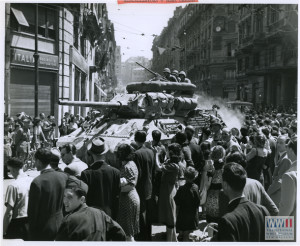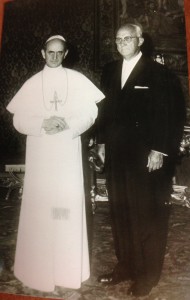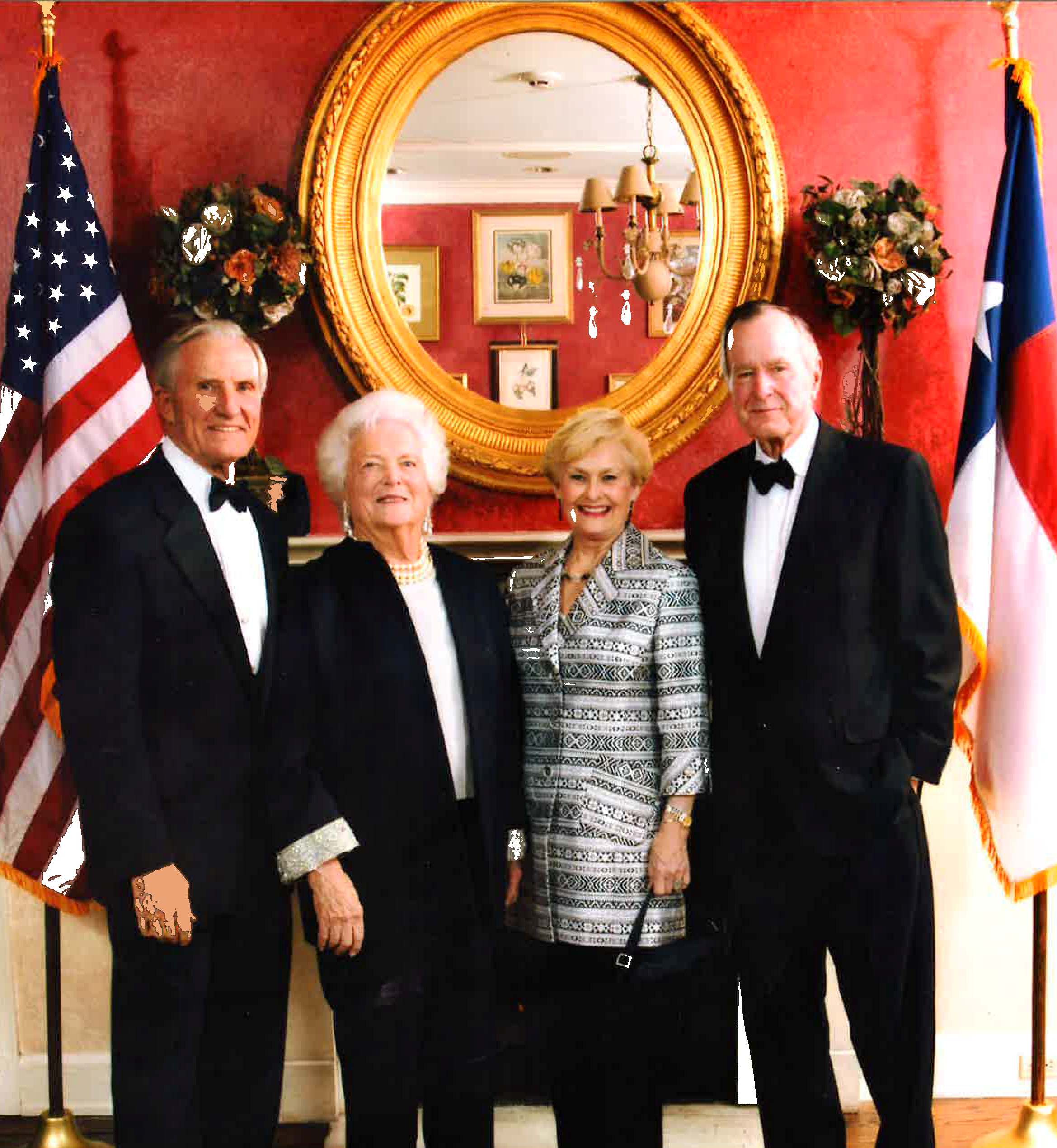COUNTDOWN TO ROAD TO BERLIN: THE ITALIAN CAMPAIGN EXHIBITS
In our last blog post of the Road to Berlin countdown, we covered the first three exhibits within The Italian Campaign gallery: Invasion of The Italian Peninsula, Fighting Up The Peninsula, and Anzio. Now, we examine the final two chapters in the Italian Campaign, Liberation of Rome and Fighting for The Gothic Line exhibits. Read on to learn about how the Allies conquered the Axis in Italy, followed by a spotlight on one of our donors, the Strake Foundation, who sponsored the Liberation of Rome.

Waves of cheers greeting the appearance of Allied tanks rumbling through the crowd lined streets of Rome following the seizure of Rome on 4 June 1944. U.S. Navy Official photograph, Gift of Charles Ives, from the collection of The National WWII Museum.
LIBERATION OF ROME
The Allies finally broke through at Anzio in May 1944, which opening the way through the Liri Valley to the Liberation of Rome. The capture of Eternal City of Rome on June 4, 1944 is a significant turning point – it was the first Axis capital to be captured – but it by no means marked the end of the campaign.
FIGHTING FOR THE GOTHIC LINE
This exhibit will cover the often forgotten military campaign after the Liberation of Rome which became a war of attrition in northern Italy. As the Germans retreated up the peninsula, they constructed forts at key passes and mountain tops. Fighting halted in the winter due to inclement weather, troop fatigue, and lack of supplies. Horses and pack animals were used to assist with the advance. Fierce fighting resumed with the return of fair weather, and the Allies broke through the Gothic Line in April 1945. By the end of the war, the Allies had pushed their way up the Italian peninsula to just south of the Alps before the Germans surrendered.
Donor Spotlight- Strake Foundation
George W. Strake was born in 1894, and raised in St. Louis, MO. He was the youngest of nine children and both of his parents passed away when he was very young. His first job was as a Western Union runner making $10 a week and putting $2 of his weekly salary into the Sunday church collection basket. He did not attend high school but was admitted to St. Louis University after taking an entrance exam. Upon graduation, the United States was in World War I. He joined the Army in Florida, and became a wireless instructor in the Army Air Corps. He fell in love with a young lady from Florida but he would not marry her because “she had more money than I did.” She did suggest to him that he should go to Mexico as “that’s where the fortunes were going to be made.”
He followed her advice and moved to Tampico, Mexico. He got a job with Gulf Oil Co. where he stayed for two years. After quitting that job, he began putting drilling deals together for fellow Americans. He eventually married Susan Kehoe, from Houston, Texas. They had their first child, Betty Sue, in Houston, and they lived for a total of seven years in Tampico, Mexico. They then moved to Havana, Cuba where he was going to explore for oil but to give himself some cash flow, he took on the Hutmobile dealership which turned out to be a totally unsuccessful venture. After residing in Havana for two years, they decided to move back to the United States “before they had to swim back.” His intent was to move to Oregon to go into the timber business, but his mother-in-law became ill and to give himself something to do while they stayed here in Houston he began putting drilling deals together in Texas. His signature accomplishment was drilling the discovery well in the Conroe Field, southwest of Conroe, Texas, in 1931. Prior to drilling the discovery well by himself he was turned down by eight major oil companies who he had asked to participate in the drilling of the initial well.
After the discovery of the Conroe Field he started the Strake Foundation. This allowed him and his wife to begin a policy of helping many needed institutions and individuals.
The Strake Foundation is still in existence and continues the many charitable works that were started by George and Susan Strake. One of their major charities was the Catholic Church and one of the major recipients of this generosity was the Vatican. A highly significant project that the Strake Foundation supported was to fund the excavations under St. Peter’s Basilica where the tomb of St. Peter was eventually found. George Strake was bestowed the honor of Knight of St. Sylvester by the Pope, which required his actual presence from time to time in the Vatican. Mrs. Annette Strake’s grandparents on her father’s side, Frank & Gladys DeWalch, were also Italian and emigrated to the United States. It is therefore appropriate that Strake Foundation sponsor the Liberation of Rome exhibit in The National WWII Museum.
George Strake died in 1969, and his work through the Foundation has been continued by the Strake Family under the guidance of their son, George W. Strake, Jr. and their third child, Georganna Parsley. Young George graduated from St. Thomas High School in Houston, the University of Notre Dame and Harvard Business School. After George Jr. graduated from Notre Dame he was commissioned an Ensign in the United States Navy where he served for two years in the Pacific Fleet on an LST. (This inspired the Strake Foundation’s support for the Life Aboard Ship exhibit within the Road to Tokyo.)
George Jr.’s love of the Navy and the United States Military was started in his formative years when he was 6-10 years old during World War II. He can remember wanting to participate in the war effort with all other Americans. As a young boy he would collect newspapers, magazines and aluminum foil, taking them to the fire station “for the war effort.” He also planted vegetables for a “victory garden” in his mother’s azalea bed. His reaction was a reflection of the spirit that existed in WWII where everyone, regardless of their age, was a participant in the war effort. His uncle flew bombers in the European Theater and his two brothers-in-law, Bob Parsley and Bob Dilworth, flew for the United States Air Force and the United States Navy. George remembers his mother crocheting blankets for hours for the troops overseas. As George Jr. says, “the reason we won this terrible war, was because all Americans were involved.”
The Strake Foundation has been a generous supporter of The National WWII Museum since its opening in the year 2000. The National WWII Museum’s work helps fulfill the Strake Foundation’s mission. The foundation strives to teach that “this is the greatest country in the world. It will not always be that way unless we are always vigilant.” We are very appreciative of the generous support the Strake Foundation provides to The National WWII Museum. George’s leadership and the foundation’s participation allow us to expand – with a sense of urgency – so we can share the stories of our WWII veterans while as many as possible are around to see it.
Up next, the The Air War gallery.
Post by Lauren Bevis, Donor Relations Manager, and Ashley Nash, Prospect Coordinator.
- Posted :
- Post Category :
- Tags : Tags: Road to Berlin Countdown
- Follow responses to this entry through the RSS 2.0 feed. You can skip to the end and leave a response. Pinging is currently not allowed.







Leave a Reply